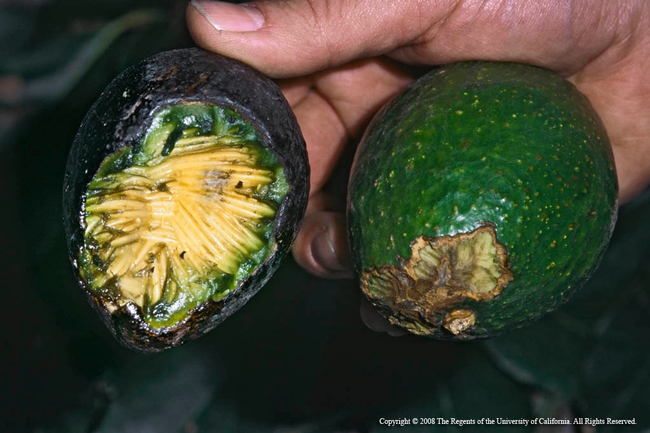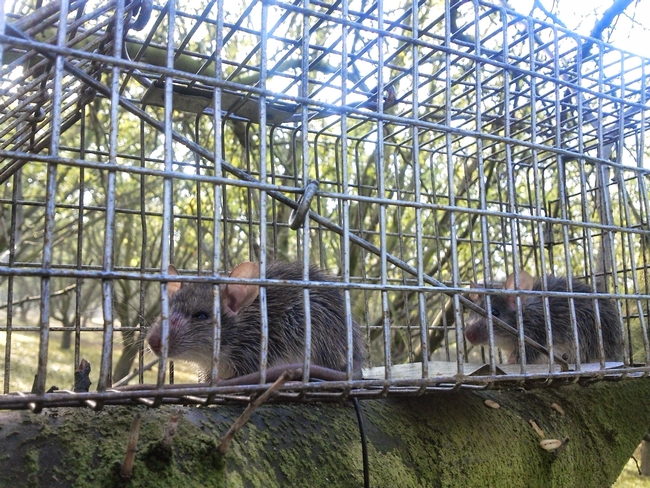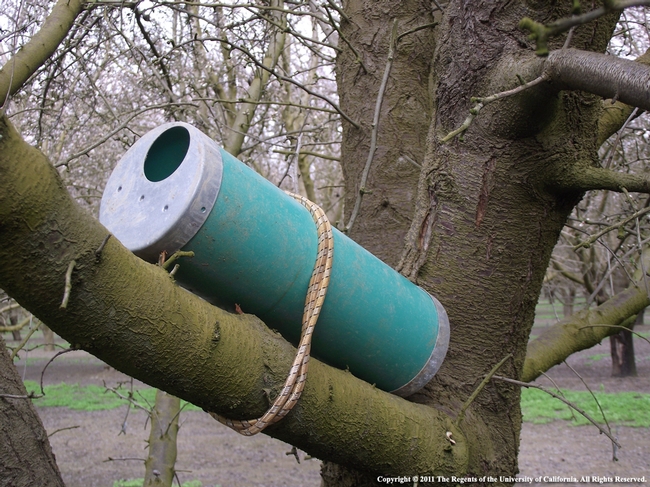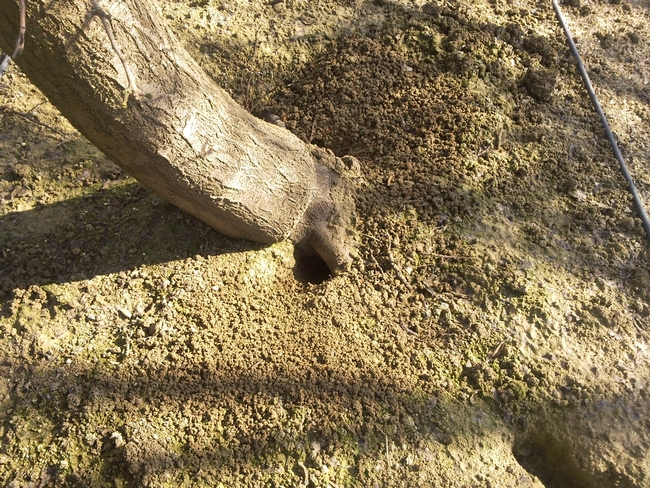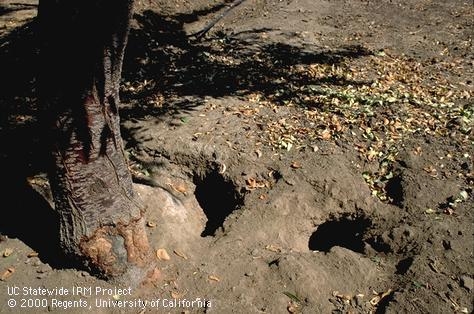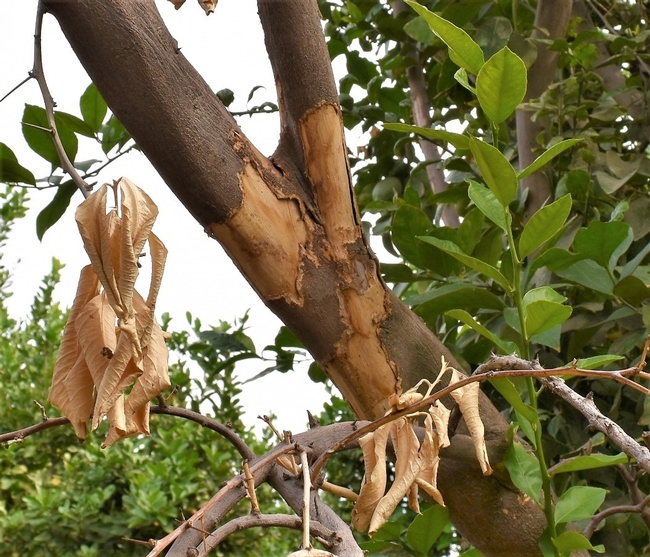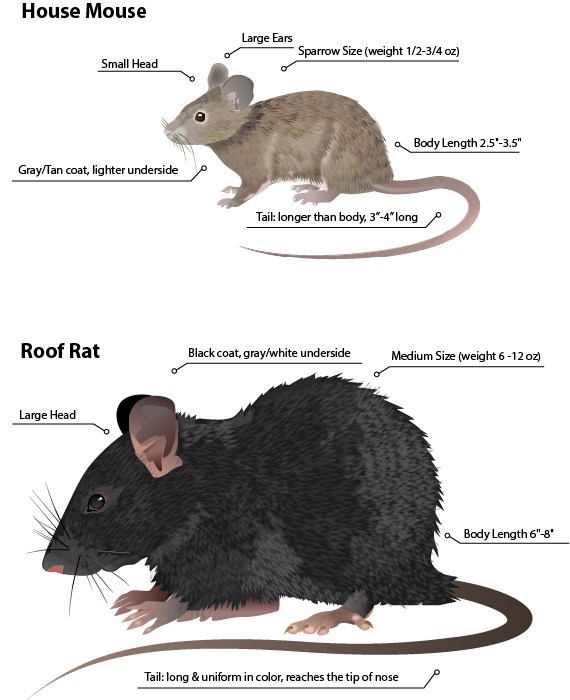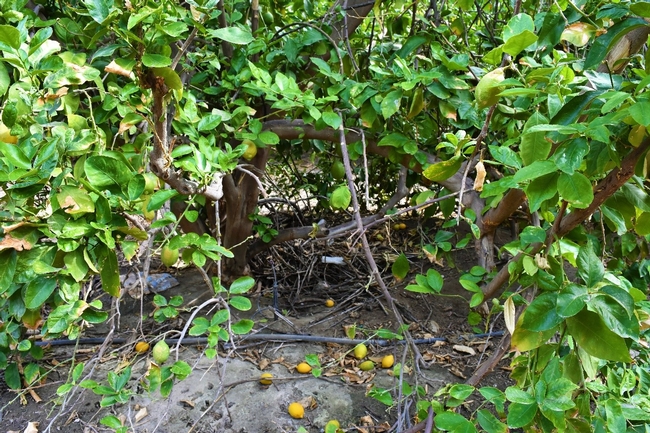
Posts Tagged: rats
Roof Rats, O MY!!
Roof rats are running rampant in California orchards this year, according to UC Agriculture and Natural Resources scientists.
“In pistachio and other nut orchards, roof rats are burrowing and nesting in the ground where they're chewing on irrigation lines, causing extensive damage,” said Rachael Long, UC Cooperative Extension advisor. “They are also nesting in citrus trees, feeding on the fruit and terrifying field workers when they jump out as people are picking fruit. The chewing pests are also girdling citrus limbs, causing branch dieback.”
The wet winter of 2017 led to lots of weed seeds for rats to eat. “Last season, rats were also nibbling on pomegranates, avocados, and other fruit and nut crops, rendering them unmarketable,” Long said.
Holes in the ground around the base of pistachio trees throughout a Yolo County orchard puzzled the grower.
“We looked for ground squirrels, but never saw any,” Long said. “We set up game cameras, but only got birds and rabbits. We put rodent bait in the holes, but the digging didn't stop.”
Long, the pest detective, cracked the case by consulting Niamh Quinn, UC Cooperative Extension human-wildlife interactions advisor based in Irvine. “She informed us that the damage we were seeing was from roof rats.”
Burrowing roof rats sounds like an oxymoron. While roof rats generally don't burrow in urban environments, their country cousins have been known to burrow.
“It's not true that they don't burrow,” Quinn said. “When I worked as staff research associate for Roger Baldwin, UC Cooperative Extension wildlife specialist, that is mostly what we studied, burrowing roof rats in orchards.”
Control measures
Baldwin said, “It seems to be a good year for rats in a number of different areas and crops throughout the state. I've received more questions and comments about rats this year than perhaps the last 10 years combined. As for bait application, putting bait down burrow systems for rats doesn't usually work too well, so I'm not surprised that approach didn't work. Growers will likely have better luck with bait stations in the trees.”
Because the rats climb, Baldwin suggests attaching bait stations to tree branches.
“In addition, elevating the bait stations will eliminate access to bait for many protected mammal species, such as kangaroo rats,” Long said. “The bait diphacinone grain can be purchased from some ag commissioners' offices. This is what Roger Baldwin said they tested and it worked.”
As for the bait stations, they should be designed so that there isn't any spillage for nontarget animals to eat, Long said.
When roof rat outbreaks occur, rodenticides are often needed to prevent crop damage. However, timing is critical as diphacinone use is highly restrictive and not allowed during the growing season, which is beginning as the weather warms.
“Check the product label for application instructions,” Long reminds growers. “It's the law.”
Identifying the pest
One way for growers to identify whether they have roof rats is by the size of the burrows. The nocturnal pests are active above ground in trees and below ground.
“Roof rats can forage away from their nest, so you won't likely find signs of their activity, such as rat droppings outside their burrow, to help identify them,” Long said.
Ground squirrels are active during the day, so they are more likely to be seen, dig holes about 4 inches in diameter and forage above ground near their burrows. Vole and mouse holes are 1- to 2-inches in diameter. Roof rat holes are typically 3 to 4 inches in diameter and might have nut shells in front of them, for example pistachio or almond shells. Rabbits will feed on seedling crops, but do not dig burrows.
Roof rats are prolific breeders that reproduce year-round, according to Baldwin. Females typically have three to five litters per year with five to eight young, enabling their populations to rapidly increase. The omnivores feed on a wide variety of plant and animal materials, allowing them to adapt to any environment, including urban and agricultural lands.
“Rats are sneaky and hard to spot,” Long said. “If you see damage, including digging in the soil but no wildlife, suspect rats.”
For more information on controlling roof rats, download Quinn and Baldwin's free UC ANR publication 8513, Managing Roof Rats and Deer Mice in Nut and Fruit Orchards at http://anrcatalog.ucanr.edu/Details.aspx?itemNo=8513.
For more information about ground squirrels, download the free UC IPM Best Management Guidelines http://www.groundsquirrelbmp.com or UC IPM Pest Note http://ipm.ucanr.edu/PMG/PESTNOTES/pn7438.html.
And there's more on rats in the orchard:
https://ucanr.edu/blogs/blogcore/postdetail.cfm?postnum=26570
https://ucanr.edu/blogs/blogcore/postdetail.cfm?postnum=24581
https://ucanr.edu/blogs/blogcore/postdetail.cfm?postnum=19525

roof rats
Whas Up in Subtropics?
There's a new Topics in Subtropics Newsletter available:
- Ah, Rats! ?
- So You Want To Install Soil Moisture Meters? ?
- Notes on Applying Gibberellic Acid (GA) to Navels in
the Southern San Joaquin Valley of California ? - Fall Leaf Tissue Sampling ?
- FREE! Citrus: UC IPM Pest Management Guidelines
http://ceventura.ucanr.edu/newsletters/Topics_in_Subtropics71533.pdf
Subscribe:
http://ceventura.ucanr.edu/news/Topics_in_Subtropics/

topics
What a Mess: Roof Rats in Orchards
The roof rat (Rattus rattus, a.k.a. citrus rat, fruit rat, black rat, or gray rat) is an introduced species of rat native to southern Asia. It was brought to America on the first ships to reach the New World and has spread around the world. This rat is the same species that carried the bubonic plague around the world and is also the reservoir host for murine typhus.
The roof rat is a common vertebrate pest in citrus and nut orchards. In citrus, it builds leaf and twig nests in trees or it can nest in debris piles, thick mulch on the ground, or in shallow burrows under the tree, especially in hot weather. In nut orchards, roof rats often nest around the base of trees. In livestock feed yards and barns, roof rats often burrow under feed bunks or into hay bales. Adult roof rats are 12-14 inches long (30-36cm) and weigh 5-10oz. (150-250g). The sleek rat has a pointed muzzle and hairless scale-covered tail that is longer than the body and head combined. They are the most active at night.
DAMAGE
Rats gnaw on electrical wires, wooden structures, and fruit and nuts on trees. They can also girdle limbs or stems, leading to mortality to part or all of a tree. Roof rats often feed on citrus, avocados, and other fruits, sometimes leaving hollow fruit skins hanging on the tree. After harvest, they damage fruit and nuts in bins by chewing them and leaving excrement. Rats are active throughout the year, and mostly at night.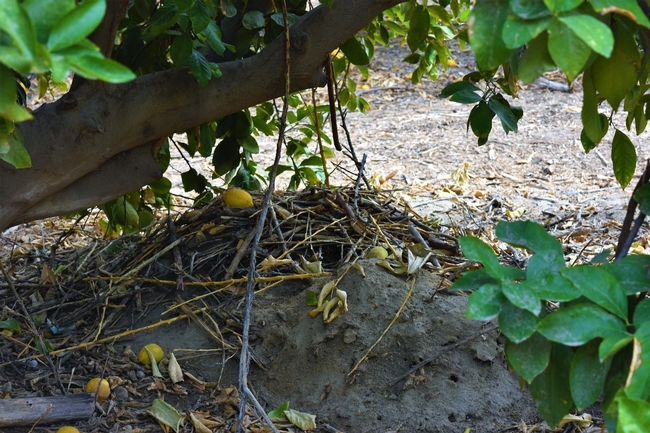
MANAGEMENT
Cultural Control
Because roof rats are such good climbers and swimmers it is hard to completely exclude them from your grove or orchard.
Your fruit trees should be isolated, not touching fences, overhead wires, or the branches of other trees. Roof rats will run along fence stringer boards or support poles, phone and cable TV wires, and tree branches to reach your fruit tree. Lower branches of the tree should not touch the ground. A low-hanging skirt of drooping branches give the rats additional access routes and provides them with protective cover while feeding. Prune tree skirts so that the ground under them is open and visible. This lack of cover makes the rats uncomfortable and more susceptible to predators.
Sanitation is also important. Use or remove all fallen fruit. Reduce shelter and nesting sites of rats. Eliminate debris and woodpiles. Store materials neatly off the ground. Thin and separate non-crop vegetation around orchards where feasible and remove dead wood from fruit trees, especially citrus and avocado.
Monitoring and Treatment Decisions
Baiting *Be sure to identify the species of rat present to avoid killing nontarget or protected species.*
The use of elevated bait stations containing 0.005% diphacinone*-treated oats (sold at some county agricultural commissioner's offices) is highly effective at controlling roof rats in orchards. Secure bait in a bait station before placing in trees on limbs 6 feet or more above the ground. Placing the bait in a secure bait station will prevent bait from dropping to the ground and creating a hazard. Bait stations should also prevent nontarget animals from feeding on the bait. Bait can only be applied during the non-bearing season, so growers must take a proactive approach to managing problematic rat populations.
Trapping
Rat-sized snap or wooden box traps placed in trees are also effective, although a more time-consuming control option. Do not use glue board traps outdoors, as birds, lizards, and other nontarget wildlife may be trapped. Rats are wary, tending to avoid baits and traps for at least a few days after their initial placement. Fasten traps to limbs and bait them with sweet fruit or nut meats, but do not set the traps until after bait is readily eaten.
Be aware that certain types of rat baits for use inside buildings are not labeled for use outdoors in orchards; these are hazardous to wildlife and should not be used.
Rats in Your Citrus
Along the mighty Santa Clara River are planted many lemons and once upon a time many Valencia orange trees. There's lots of wild life along the river which causes some issues with food safety. One of the many creatures are rats and when things dry up they start foraging further and further for food. They really like citrus and can cause a lot of damage. What I first thought was sun burn damage turned out to be rat feeding on the bark and cambium of these lemon trees. The damage wasn't in the right position to be sunburn damage. Inside the canopy, often on the north facing branch.

IMG 1600

